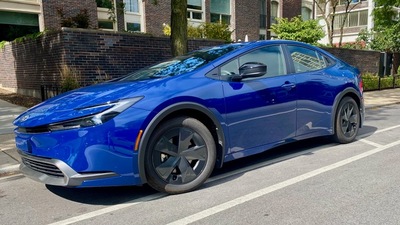2024 Toyota Prius Prime Review By Larry Nutson
2024 Toyota Prius Prime
A Plug-in Hybrid (PHEV)
By Larry Nutson
Executive Editor and Bureau Chief
Chicago Bureau
THE AUTO CHANNEL
SEE ALSO: Toyota Reviews 1994-2025
Many a car owner has become a champion of eco-friendly transportation, changing to a sustainable alternative to traditional gas-powered (ICE) vehicles. We all as individuals should strive to reduce our personal carbon footprint, contributing to the mitigation of urban air pollution and the broader fight against climate change. This shift towards electric-powered transportation is a small yet impactful step individuals can take to promote a healthier environment, showcasing how modern technology can align with eco-conscious living.
The electrified vehicle (EV) market is in flux. Battery-powered all-electric vehicles sales continue to increase but not at the rate automakers had thought. Most all automakers have scaled back production and recalibrated their introduction of new BEVs. Toyota has been cautious about the EV transition but the world is still moving towards all-electric vehicles. This adaptation is coming a little slower than planned, and Toyota's plans for U.S.-built EVs have been pushed back a bit.
Hybrid (HEV) and plug-in hybrid (PHEV) powertrains are a good choice for someone who wants to reduce their personal carbon footprint by moving away from a traditional pure ICE-powered car but is not afforded by their living arrangements to drive an all-electric vehicle (BEV) that requires at-home Level 2 battery charging for the best user experience. On average, 36% of US households do not have access to a dedicated parking space that would allow for overnight battery charging.
A PHEV is a good interim step until such a time as the public charging infrastructure, especially that for longer distance highway driving in the US, is fully developed and operational. The US Federal target remains 500,000 public charging ports by 2030. Today we have about 193,000 public charging ports in 71,000 locations across the country.
In 2016, the Prius Prime was introduced to the world as a plug-in hybrid model that offered the best-of-both worlds, operating on battery electric power for a limited range or hybrid gas-electric power for longer range drives. In 2022 a new Prius Prime model was introduced, with a manufacturer estimated EV range of up-to 44 miles and an impressive 6.6-second 0-60 time.
This new Prius was introduced in the US as a 2023 model. I had the opportunity to drive the new Prius back then, which you can read about HERE
For model year 2025, the model keeps on going with a slight name change to Prius Plug-in Hybrid. The change to the Prius Plug-in name is intended to help consumers more easily identify the powertrain choices among Prius models. All too often automakers use different names or branding to describe identical technology. This practice has led to some confusion among car shoppers. Technology name harmonization is a good practice.
The 2025 Prius Plug-in Hybrid will also adopt a “PHEV” badge on the rear, indicating its Plug-in Hybrid Electric Vehicle powertrain. It will be available in three grades: SE, XSE and XSE Premium.
There’s no special equipment needed for home charging, just plug the Prius Plug-in Hybrid into a standard household outlet using the supplied cable (Toyota recommends using a dedicated GFI 15A outlet). The battery will recharge in about eleven hours on a standard 120V home outlet and in about four hours on a Level 2 charger under ideal conditions. And if you can’t plug it in, it’s okay; the Prius Plug-in Hybrid will continue to run like an efficient hybrid.
My recent drive experience was in a 2024 SE model with a total MSRP of $34,884 including a few options and shipping. It’s technically identical to the 2025, save the new name. My driving consisted of a mix of local Chicago city driving as well as a couple of highway drives to Chicago’s western suburbs. Around town I was able to drive in all electric mode making use of the 44 miles of range. Out on the highway the estimated combined rating in Hybrid mode is 52 mpg. The EPA combined electric and gasoline rating is 127 MPGe.
More information and details on the Toyota Prius can be found at: www.toyota.com.
The good news for those who are shopping for an EV, whether it be BEV, HEV or PHEV, is more new models are coming to the market. There’s more to choose from depending on the role you want an EV to play in your household fleet. According to Fuel Economy.gov there are 242 different EV model variants to choose from. Body configurations include Small Cars, Family Sedans, Luxury/Upscale Sedans, SUVs, and Pickups. Have a look: HERE
The future is electric. Happy motoring!
© 2024 Larry Nutson, the Chicago Car Guy






